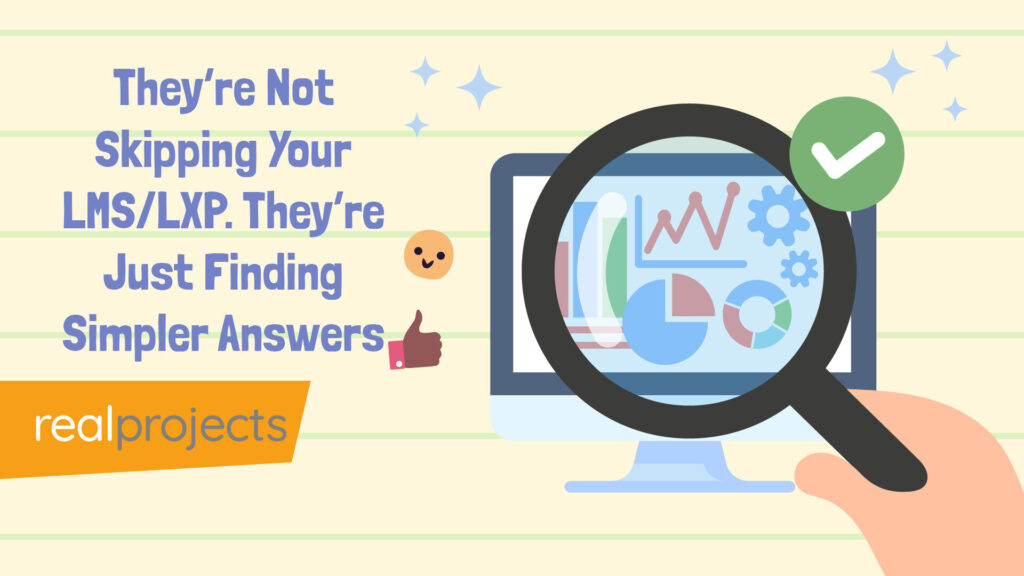Why It Matters?
Microlearning reshapes professional development to fit modern, busy schedules, enhancing retention, engagement, and cost-effective training solutions.
The Basics
Microlearning involves compact, focused learning sessions typically lasting 1–5 minutes.
It is delivered in formats such as text, video, or interactive content, suitable for mobile-first learners.
How It Impacts You
It significantly cuts development costs, speeds up training processes, and supports continuous development, crucial for maintaining competitive advantages in fast-evolving industries.
Reality Check
Implementing microlearning requires careful management to avoid learner overload and ensure content quality and consistency.
Ideas To Try
Integrate microlearning into existing training programmes to enhance onboarding, compliance training, and skill development.
Use efficient content creation tools. Develop quickly, test, measure and learn.
How To Begin
Start by defining clear training objectives, choosing suitable creation tools, and creating a pilot module.
Gather feedback, refine your approach, and expand your microlearning strategy.
Why Microlearning Works and How to Start Using It Today
Ever felt overwhelmed by long training sessions? Is your LMS/LXP packed with long, boring, courses that are not being used.
Traditional, lengthy training modules can feel daunting, especially for busy professionals.
Enter microlearning—a flexible, bite-sized approach to learning that fits into even the tightest schedules.
By breaking down complex topics into short, focused modules, microlearning allows for better retention, engagement, and deployment. Scott Hewitt asks: “You see so much elearning content that is outdated and no longer suitable for today’s fast-paced workplaces, microlearning is one way to keep people learning continuously without overwhelming their busy schedules?”
The Data Behind Microlearning’s Impact
Microlearning is more than a trend; it’s supported by compelling data that highlights its effectiveness:
- Improved Completion Rates: Microlearning courses see completion rates 15%–20% higher than traditional eLearning courses. (Source: Skill Success)
- Flexibility: Learners can access materials on-demand, fitting training into busy schedules. (Source: LinkedIn Learning)
- Efficiency: Microlearning is 5–10 times more efficient for time-strapped learners. (Source: ThriveMyWay)
- Development Costs and Speed: Adopting microlearning can cut development costs by about 50% and increase development speed by 300%, making it a cost-effective and timely training solution. (Source: Hubspot)
- Future of Work and HR Strategies: Microlearning supports HR activities by providing flexible, employee-centric development opportunities. It’s an excellent tool for onboarding, skill development, and employee engagement—crucial areas for maintaining a competitive edge in today’s dynamic work environments. (Source: Learning Guild)
What Is Microlearning?
Microlearning refers to compact, focused learning sessions typically lasting 1–5 minutes.
Delivered in various formats such as text, video, audio, and animations, it’s designed to make learning convenient and impactful.
Unlike traditional courses, microlearning doesn’t demand hours of uninterrupted attention.
Instead, learners can complete short modules during a coffee break, on the move or between meetings.
By providing information in manageable chunks, microlearning simplifies even the most complex subjects, making it easier to absorb and apply knowledge.
Scott Hewitt wonders: “Given the pressure on people’s time, microlearning helps people quickly explore new areas of interest, so they can test what’s valuable before diving deeper?”
The Core Advantages of Microlearning
The value of microlearning lies in its versatility and efficiency. Here’s why organisations are embracing this approach:
- Faster Development and Deployment
Developing a 30-minute elearning course can take weeks, even months. Microlearning modules can be created and released in a matter of days. Using tools like 7Taps, teams can build short, visually engaging lessons in the time it takes to draft an email. - Enhanced Engagement
Microlearning forces creators to focus on the essentials. By stripping away unnecessary information, it delivers clear, concise content that holds attention. Learners are less likely to zone out or feel overwhelmed, leading to better engagement and knowledge retention. - Supports Continuous Learning
Rather than a one-and-done training session, microlearning fosters an ongoing learning culture. Learners can revisit short lessons as needed, ensuring they stay up-to-date and confident in their knowledge. - Cost-Effective Localisation
Localisation can be one of the most time-consuming and expensive aspects of elearning. With microlearning, you’re dealing with smaller content chunks, making it faster and cheaper to translate and adapt for multiple languages. - Accessibility and Convenience
Microlearning works on virtually any device, making it ideal for today’s mobile-first learners. Whether accessed via smartphones, tablets, or desktops, learners can engage with content wherever they are—on-site, at home, or during their commute. - Promotes Knowledge Retention
Studies show that learners forget up to 90% of what they learn within a week if there’s no reinforcement. Microlearning combats this with frequent, bite-sized lessons that reinforce key points over time. This strategy aligns with the “spacing effect,” which demonstrates that repeated exposure to information improves long-term retention.
Real-World Success Stories
Transforming Apprentice Training
An electrical contracting company faced a significant challenge: apprentices were disengaged and retention rates were low. The onboarding process relied on lengthy, in-person sessions that failed to resonate with younger, tech-aware recruits.
The company implemented a microlearning strategy. Weekly lessons were sent directly to apprentices’ phones, covering essential safety protocols, wellness tips, and practical skills. The result? Faster onboarding, increased engagement, and a noticeable improvement in retention rates.
Building a Learning Culture
In another case, a corporate office with high error rates and low employee satisfaction used microlearning to turn things around. By embedding short modules into daily workflows, employees were exposed to key concepts gradually, creating a seamless learning experience. Over time, error rates dropped, customer satisfaction increased, and the office was ranked as the top-performing branch.
These stories highlight a crucial point: microlearning is not just a tool but a strategy for driving meaningful change within organisations.
How to Get Started with Microlearning
Ready to introduce microlearning to your organisation? Here’s a step-by-step guide to ensure success:
- Define Your Goals
What do you want to achieve with your training? Whether it’s improving safety compliance, boosting sales, or enhancing customer service, clear objectives are essential. - Choose the Right Tools
Platforms simplify the creation of microlearning content. These tools allow you to incorporate text, images, videos, and quizzes, ensuring a dynamic learning experience. - Start Small
Focus on a single topic or objective for your first module. For example, a short lesson on “Effective Email Writing” can set the tone for future modules and demonstrate the value of microlearning to your team. - Test and Iterate
Gather feedback from learners to identify what works and what doesn’t. Use this input to refine your approach and improve future modules. - Plan the Learning Journey
Microlearning works best when integrated into a broader learning strategy. Use it to build anticipation before a training session, reinforce learning afterward, or provide ongoing development opportunities. - Measure Success
Track engagement metrics, quiz results, and user feedback to assess the impact of your microlearning strategy. This data will help you fine-tune your approach and demonstrate ROI to stakeholders.
Scott Hewitt challenges: “My advice to organisations is simple: get started—it’s never as difficult as you think. Could it be that embracing microlearning is easier than you’re imagining?”
When to Use Microlearning
Microlearning is highly adaptable, making it suitable for a wide range of scenarios:
- Onboarding: Provide new hires with quick lessons on company policies, team introductions, and office layouts.
- Skill Refreshers: Reinforce critical skills, such as negotiation techniques or safety procedures.
- Compliance Training: Deliver mandatory training in manageable doses, ensuring better compliance rates.
- Product Updates: Keep employees informed about the latest product features or updates.
- Soft Skills Development: Cover topics like communication, time management, and conflict resolution in bite-sized sessions.
Overcoming Challenges with Microlearning
While microlearning offers many advantages, it’s not without challenges. Here are a few to watch out for:
- Avoiding Overload: Don’t bombard learners with too many modules at once. Space out lessons to give them time to absorb and apply the information.
- Maintaining Quality: Short doesn’t mean shallow. Ensure every module provides valuable, actionable insights.
- Ensuring Consistency: Align microlearning modules with your organisation’s broader learning objectives to create a cohesive experience.
A Future-Ready Approach
Microlearning is more than a trend—it’s a reflection of how people prefer to learn in today’s digital age. It offers flexibility, scalability, and the ability to deliver targeted content quickly.
Whether you’re a seasoned L&D professional or new to the field, microlearning provides an opportunity to rethink how you deliver training and engage learners.
So, what’s your first step? Identify a single challenge within your organisation, create a microlearning module to address it, and see the difference for yourself. What will you tackle first?
Q: What is meant by microlearning?
A: Microlearning is about delivering small, focused learning units that can be understood and applied quickly. It helps people learn when they have a spare moment, making it easier to fit learning into a busy schedule.
Q: What is an example of micro training?
A: An example might be a two-minute video showing how to handle customer complaints. Instead of a long course, it’s a quick lesson that can be watched anytime, making learning more flexible and convenient.
Q: What is the meaning of micro training?
A: Micro training means providing short, targeted lessons that focus on a single skill or topic. It avoids long, time-consuming sessions and helps people gain knowledge or improve a skill in quick, easy-to-manage steps.
Q: What is the main benefit of microlearning?
A: The main benefit is that it saves time and simplifies learning. By breaking content into small pieces, it helps people learn more efficiently, remember what they’ve learned, and stay engaged without feeling overwhelmed.



